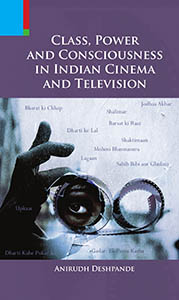
Class, Power and Consciousness in Indian Cinema and Television
AUTHOR- Anirudh Deshpande
| HB ₹595 . $39.95 . ₤26.95 |
PB ₹295 . $19.95 . ₤13.95 |
|
| e-Book ₹265 . $17.95 . ₤13.95 |
INFORMATION
- AUTHOR : Anirudh Deshpande
- HB ISBN : 978-81-908918-2-0
- PB ISBN: 978-93-80607-80-1
- EBOOK ISBN : 978-93-84082-28-4
- HB Year : 2009, PB Year: 2013, EBOOK Year: 2016
- Extent : xviii + 170 pp.
- Discount available on checkout
- Usually dispatched within 3 to 5 working days.
Class, Power and Consciousness in Indian Cinema and Television
| HB ₹ 595 . $ . ₤ |
PB ₹ . $ . ₤ |
|
| POD ₹ . $ . ₤ |
e-Book ₹ . $ . ₤ |
INFORMATION
- AUTHOR – Anirudh Deshpande
- ISBN – 978-81-908918-2-0
- Year – 2009
- Extent: 400 + 40 coloured illustrations
- 10% discount + free shipping
- Usually dispatched within 3 to 5 working days.
Since the beginning of the twentieth century, cinema has influenced social consciousness in India. Like printing and photography, which had exerted a formative influence on power, information and knowledge before it, cinema has influenced millions of people in a myriad ways.
It is a well known fact that cinema, and its cousin television, comprise a media which is central to the self-perception of contemporary Indians. Indeed, it would not be wrong to say that the visual representations of social realities in this media shape popular mentality in a country with an old, influential and thriving film industry. In sum, being Indian today is often expressed in the idiom popularized by Hindi cinema and television.
This book offers a historical understanding of the Indian Audio-Visual media. It asserts that the media is essential to the bourgeois domination of a system in which democracy normally does not work for the poor. This book narrates the history of Indian cinema while simultaneously examining the histories of the Indian nation portrayed in this cinema. It analyses how and why modern visual narratives became an instrument of bourgeois hegemony in colonial and post-colonial India. This tightly written volume examines and deconstructs the relationship between fact and fiction, history and imagination, nationalism and communalism, nation and gender, history and war, media and mentality and cinema and social identities.
The Author
Dr Anirudh Deshpande is Assistant Professor of History, Motilal Nehru College (E), University of Delhi. He has been a UGC Junior Research Fellow, Post-Doctoral Fellow at ICHR and Nehru Fellow at the Nehru Memorial Museum and Library (NMML), Teen Murti. During 2000-1, he was a Consultant Historian with the United Nations Drug Control Programme (UNDCP), Regional Office for South Asia assigned with the task of writing a scientific paper on modern state control of opium in India since the colonial period.
Dr Deshpande has co-edited, with the late Professor Partha Sarathi Gupta, a volume of essays on the colonial Indian army entitled The British Raj and its Indian Armed Forces, 1857-1939 (New Delhi, 2002). He is the author of British Military Policy in India, 1900-1945: Colonial Constraints and Declining Power (New Delhi, 2005).
Since the beginning of the twentieth century, cinema has influenced social consciousness in India. Like printing and photography, which had exerted a formative influence on power, information and knowledge before it, cinema has influenced millions of people in a myriad ways.
It is a well known fact that cinema, and its cousin television, comprise a media which is central to the self-perception of contemporary Indians. Indeed, it would not be wrong to say that the visual representations of social realities in this media shape popular mentality in a country with an old, influential and thriving film industry. In sum, being Indian today is often expressed in the idiom popularized by Hindi cinema and television.
This book offers a historical understanding of the Indian Audio-Visual media. It asserts that the media is essential to the bourgeois domination of a system in which democracy normally does not work for the poor. This book narrates the history of Indian cinema while simultaneously examining the histories of the Indian nation portrayed in this cinema. It analyses how and why modern visual narratives became an instrument of bourgeois hegemony in colonial and post-colonial India. This tightly written volume examines and deconstructs the relationship between fact and fiction, history and imagination, nationalism and communalism, nation and gender, history and war, media and mentality and cinema and social identities.
The Author
Dr Anirudh Deshpande is Assistant Professor of History, Motilal Nehru College (E), University of Delhi. He has been a UGC Junior Research Fellow, Post-Doctoral Fellow at ICHR and Nehru Fellow at the Nehru Memorial Museum and Library (NMML), Teen Murti. During 2000-1, he was a Consultant Historian with the United Nations Drug Control Programme (UNDCP), Regional Office for South Asia assigned with the task of writing a scientific paper on modern state control of opium in India since the colonial period.
Dr Deshpande has co-edited, with the late Professor Partha Sarathi Gupta, a volume of essays on the colonial Indian army entitled The British Raj and its Indian Armed Forces, 1857-1939 (New Delhi, 2002). He is the author of British Military Policy in India, 1900-1945: Colonial Constraints and Declining Power (New Delhi, 2005).
Table of Contents
Table of Contents
| Preface | ix-xvii |
| Images and Power in Modern Visual Narratives | 1-50 |
| Historiography or Historiophoty a Historian’s Dilemma | 51-70 |
| The Imagined Nation in Hindi Cinema Historicals | 71-95 |
| Hindi Cinema Narrative of a Bourgeois Nation-State | 96-126 |
| War and History in Hollywood and Hindi Commercial Cinema | 127-155 |
| Select Bibliography | 156-159 |
| Index | 160-169 |




